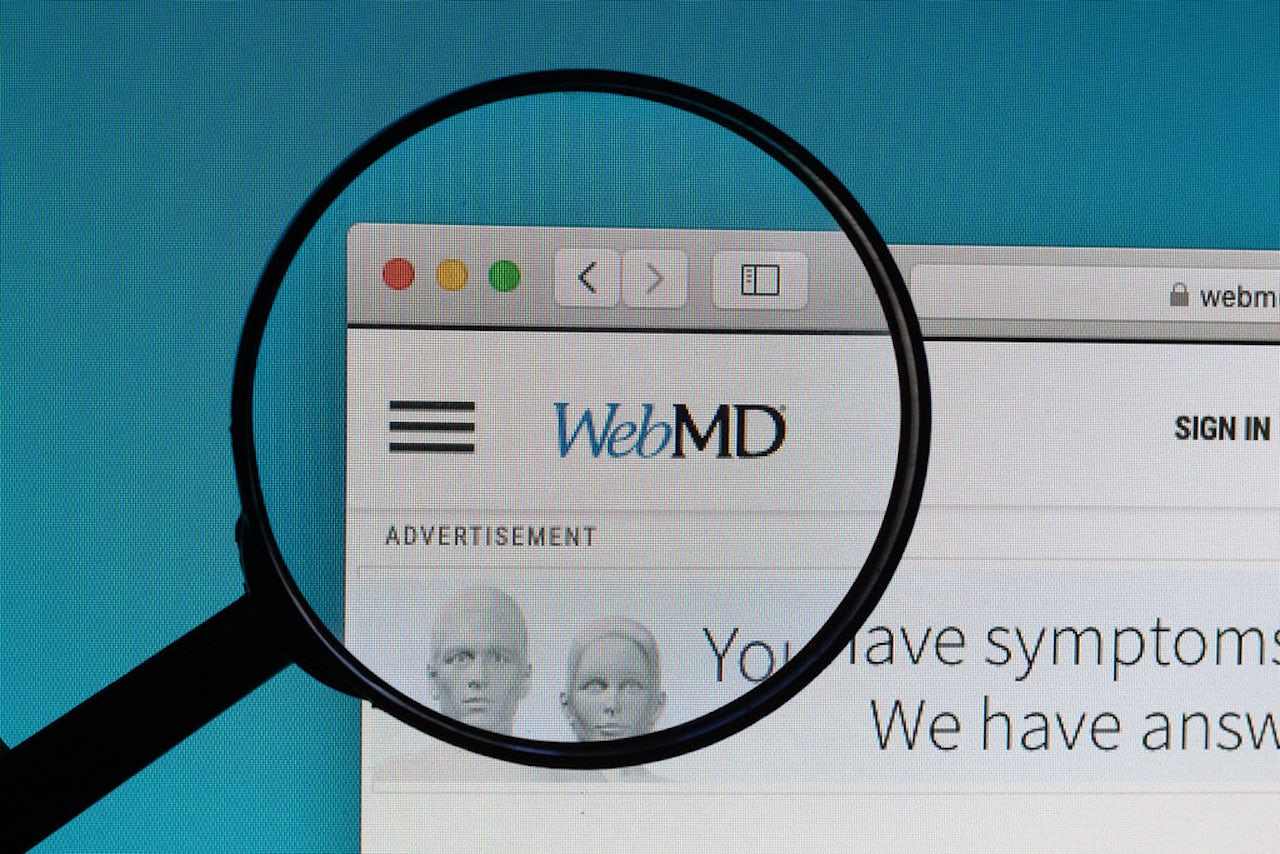Did you know that you can get cancer under your toenail?
Manhattan podiatrist Dr. Emily Splichal said her patients think they know all about it.
“If you have a pigment that runs through your nail like a color, you go to WebMD, you look up ‘dark pigment,’ and it will say it’s possibly a melanoma,” said Splichal in an interview with The Outline. “I have patients freaking out. Most of the time it’s just a pigment.”
A photo gallery on WebMD says that dark lines under the nail “should be investigated as soon as possible. They are sometimes caused by melanoma, the most dangerous type of skin cancer.” The caption ends there. And in the footer of every WebMD page reads the disclaimer: “WebMD does not provide medical advice, diagnosis or treatment.”
We’re living in the age of WebMD, where even podiatry is terrifying and confusing. We’re also in the age of Everyday Health Group, but WebMD has been the most influential health website for the past two decades. It boasts more unique visitors than any private or government health care website.
The clicks have led to an impressive revenue. In 2017, WebMD was purchased for $2.8 billion by the juggernaut investment firm KKR & Co. According to WebMD spokeswoman Patricia Garrison, the site reaches “80 million unique visitors” per month. It has been the most popular heath site until June, when competitor Healthline surpassed it by five million unique visitors per month.
Splichal said she often has to talk patients off anxiety ledges due to something they read on WebMD. Other times, WebMD has made her patients feel like they know everything, and that she — a medical professional — was incorrect in her assessments. On occasion, however, WebMD has had a positive influence. Splichal even admitted to using it herself sometimes. Besides, dark pigment can indicate melanoma under nails in certain circumstances.
“You do have times where patients come in a little bit more informed, which is positive,” said Splichal. “It’s just hard for them to grasp the minutiae and nuance of anatomy and pathology, which is something only a doctor can see.”
We use WebMD because it is ubiquitous, quick, and there — and because it takes too much effort to find what we’re looking for in the Journal of the American Medical Association. But, people don’t exactly love WebMD. Our Google searches reflect our ambivalence and skepticism. If you type “is WebMD” into Google (as I asked my husband to do on his computer), the top searches include, “Is WebMD a reliable source” and “is WebMD a credible site.”
Although consumers struggle with what to make of the site, WebMD seems comfortable with its classification.
“WebMD is not a diagnostic tool and should not be used to self-diagnose,” said Garrison in an email to The Outline. “Our content and the information available on symptoms are intended for informational purposes and to support people in taking action for their health.”
This murkiness is what keeps WebMD’s engines running. The company has carved out a lucrative, brilliant limbo in which the onus falls on the consumer to sift through complex messaging about their own health. WebMD’s information is reliable and reviewed by medical professionals, but we’re not supposed to take it too seriously. While WebMD itself is a for-profit business that does not need accreditation or licensure as an institution, its content is “ a credible, authoritative source of health information,” according to its editorial policy. Advertisements might show us a flashy new anti-depressant drug in the middle of an article about depression, but we’re not supposed to relate the two in any way. And although we aren’t supposed to rely on WebMD, people absolutely need it in a country where going to the doctor can set you back a rent payment; I’ve used it several times this week alone.
Besides, it’s a top search result in almost any health query. It’s unavoidable and habit-forming. We are all perpetually sick and broke, so we need a quick, easily digestible diagnosis in Wikipedia form. And WebMD’s SEO and Google ranking are really good. The site is always there for us.
WebMD was launched in 1998 by web entrepreneur Jeff Arnold who, a year after it was created, became a multi-billionaire when WebMD merged with another company, Healtheon. The year after that, Arnold left WebMD; nowadays, he runs another health site called ShareCare.
In its early days, WebMD featured quick-hit articles by doctors and written material cribbed from scholarly medical books. WebMD was also heavily community-focused, with chat forums and an educational subscription service for physicians called Medscape, which is still around.
WebMD was not alone, and the competition was strong. The venerable Mayo Clinic in Minnesota started a website, MayoClinic.org, around the same time, which now racks up around 50 million unique visitors a month. But every piece of MayoClinic.org content requires approval from at least three different medical professionals, according to Dr. Brooks Edwards, a cardiologist who served as MayoClinic.org’s medical editor in chief for its first 11 years.
“Mayo Clinic is a conservative operation and the Internet was just starting. The clinic was worried that being on the Internet was going to impact the name negatively,” Edwards said. “We didn’t even want to call it Mayo Clinic, we called it the Online Health Network...There’s obviously wonderful content out there and some crazy content, and oftentimes a consumer is left trying to figure out what’s valuable.”
As millions of people got online in the following years, WebMD succeeded in figuring out what its users might find “valuable,” and began to resemble its current form. The site launched its popular Symptom Checker, in which an algorithm can diagnose you with a disease, as well as pop-science articles written by doctors like “This is why you’re fat” and “The truth about flip-flops” (there are also serious articles on topics such as ectopic pregnancy and the total lack of a link between the measles vaccine and autism.
In 2008, WebMD posted an editorial policy that touted a thorough, medically reviewed process. Their policy hasn’t changed much since, according to Garrison, who wouldn’t say what initially prompted the creation of the policy.
“While our editorial policy is revisited and reviewed regularly, the policy has remained consistent over time,” Garrison said in an email to The Outline. “Our content is written in plain language, easy to understand and respectful of people’s time. Accuracy and reliability are paramount. We have a team of experienced WebMD board-certified physician editors who review content for accuracy.”
Garrison would not divulge how many people work for WebMD, and if its editors — assuming it has editors — are paid. KKR’s purchase of the site in 2017 means that little of that information is publicly available. Despite multiple attempts, I was unable to secure an interview with any medical or editorial professionals on staff.
When the media attacks WebMD’s credibility, however, its marketing department is ready on the defensive. When Vox tore apart some of WebMD’s weight loss articles in 2016 after it touted unsubstantiated supplements, WebMD quickly released a statement about its editorial integrity and updated its weight loss pages to reflect more authoritative sources (the statement has since been taken down).
Credibility is certainly better Internet business these days. Before 2011, Google listings were easily corruptible. Anyone with enough money could trick the search engine by paying websites to link back to them, or by posting quality links to their site. When Google first released its “Panda” algorithm in 2011, revising Google searches to punish meaningless content farms with lower rankings, websites had to button up while learning everything about SEO.
Google has also cracked down specifically on medical and financial information. WebMD now has to compete with Google’s own “knowledge panels,” which appear at the top of a Google search after you type something in.
“That panel is put together by Google’s partners and people they trust. It will say the source at the bottom, usually something like Mayo Clinic,” Barry Schwartz, a search advertising expert and CEO of the software company Rusty Brick, told me. It takes away a lot from WebMD and sites like Healthline, and places that are trying to rank for those types of symptoms.”
With all the traffic it generates, WebMD appears to operate a fairly lucrative advertising business; the site is stuffed with ads from pharmaceutical companies. This leads to a perfectly legal conflict of interest, or at the very least, visual confusion.
“Our advertising policy is clear. WebMD recognizes and maintains a distinct separation between advertising and editorial content,” said Garrison, citing WebMD’s ad policy. “All advertising on the WebMD Network is clearly and unambiguously identified as either ‘Advertisement,’ ‘From Our Advertiser,’ ‘Information from Industry’ or similar. A click on an advertisement may only link the end user to the advertiser's site or to a relevant sponsored content area on a WebMD property.”
Like many websites, WebMD features a section of sponsored content, including this article, headlined “Is my penis normal?” If you click through, It’s a lengthy ad for the drug Xiaflex, which treats a painful condition called Peyronie’s disease in which the erection curves substantially. Curved erections are common, but Peyronie’s disease affects about 10 percent of middle-aged men.
WebMD is hardly the only health site to run ads from drug companies; the Mayo Clinic uses pharma ads to finance its website, too.“In the world we live in, patients are bombarded by medical ads. You can't watch a football game without seeing ads for these things,” said Edwards, the Mayo Clinic cardiologist. “The important thing is to educate the consumer that this is an ad. They have a stake to sell you something. That’s different than unbiased health information.”
The Food and Drug Administration has strict rules about the content within pharmaceutical advertisements, including the fact that manufacturers must be truthful and not misleading. They must also name all significant risks involved with the product. These rules apply to pharmaceutical ads across all media, including online.
However, there are cute ways around these laws. In these sponsored articles for immunotherapy cancer treatment and this prostate treatment procedure, there’s no mention of a pharmaceutical, so there’s no need to mention any risks. And they don’t look like ads at all, either — they look like WebMD content.
“Medicine is based on informed consent of the patient. I’m not sure the advertising of pharmaceutical products meets the criteria of informed consumers being able to make informed consent,” said Darren Woolley, former neuropathologist and current advertising executive for marketing firm TrinityP3. In other countries, pharmaceutical companies must follow strict rules around pharmaceutical messaging. In the U.S. however, companies like WebMD can thrive in a gray area, profiting from a broken system. “A growing proliferation of ads is driving demand for expensive treatments despite the clinical effectiveness of less costly alternatives,” said the American Medical Association in 2015, calling for a ban on direct-to-consumer pharmaceutical ads.
WebMD, in comparison, runs rogue, toeing the line between toe cancer and toe fungus. But it just so happens that WebMD is at the nexus of an unregulated digital medical ecosystem in which consumers are expected to make informed choices in a sea of confusion.
All of this is to say that I have a headache at the moment. I think it’s a brain tumor, so thank god for the many commercial treatments out there.



